![]()
How to Clean Purge Solenoid Valve? [Step-by-Step]
DISCLAIMER: AS AN AMAZON ASSOCIATE I EARN FROM QUALIFYING PURCHASES. THIS POST CONTAINS AFFILIATE LINKS THAT WILL REWARD ME MONETARILY OR OTHERWISE WHEN YOU USE THEM TO MAKE QUALIFYING PURCHASES. FOR MORE INFORMATION, PLEASE READ MY EARNINGS DISCLAIMER.
|
Cleaning a purge solenoid valve can be done in two different ways and which one you pick depends on how much technical knowledge you have. Since our main objective is to get rid of the dirt that does not let it work properly, just rinsing internal components without opening should get the job done for most people.
If you have a broken casing or a faulty solenoid, there isn’t much that you can do and you will have to replace the purge solenoid valve. However, if you tested the solenoid’s coil, and you don’t see any damage in the housing, you can try to clean the valve and in many cases it will start working again, saving you some money.
The purge solenoid valve is a simple device; it consists basically of three main parts:
- A casing with two connectors for the fumes inlet and outlet.
- An electrical plug for the solenoid’s control.
- An internal solenoid and a plunger (or flap) that, depending on the solenoid’s state, (engaged or disengaged), will allow the fumes to pass to the outlet pipe or not.
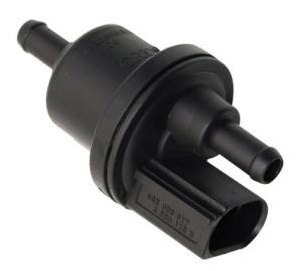
There are three main problems that a purge solenoid valve may have:
- The casing (including the inlet and outlet pipes) could be cracked, allowing the fuel fumes to escape and, most of the time, generating a vacuum leak.
- The solenoid’s coil could be cut or damaged, preventing it from moving the plunger or flap properly.
- The most common problem occurs due to debris or carbon build-up, the inner electromechanical part sticks, preventing the purge solenoid valve from fully opening or closing. Sometimes it can get stuck in a fixed position and it won’t move at all.
Cleaning the solenoid purge valve will get rid of this debris and this is how we do it:
- Locate the valve; unplug the vacuum lines and the electrical connector. You can now remove the valve from the car.
- You can try to clean it without opening it. If that doesn’t work and you have good technical skills, or you want to do a deep cleaning, you could open the purge solenoid valve.
Cleaning your purge solenoid valve without opening it
The step-by-step process of cleaning without opening the valve:
Step #1. Spray carb or MAF cleaner
Spray a good amount of carb cleaner or MAF cleaner into both tubes of the purge solenoid valve.
Step #2. Shake and wait
Cover both ends with your fingers and shake well. Leave both ends covered and wait several minutes for the cleaner to lose dirt.
Step #3. Drain liquid
Uncover the valve’s tubes and let the liquid drain out. It should be dark, with signs of dirt, charcoal, and debris. Repeat steps “1” and “2” as many times as necessary. The ideal thing would be that you do it until the liquid leaves the valve clean.
If the liquid came clean the first time, it’s probably because your purge solenoid valve isn’t clogged by dirt or debris and dirt is unlikely to be the problem. You may want to keep doing this anyway; it’s not going to do any harm to your valve.
Step #4. Spray contact cleaner
Spray contact cleaner in the valve’s connector and the car switch.
Step #5. Let it dry
Let everything dry.
Opening and deep cleaning your purge solenoid valve
Purge solenoid valves are not meant to be opened. You are going to manage to open it using a small flat blade screwdriver and something sharp like a small knife to force the case open.
Step #1. Remove glue
Most purge solenoid valves like the Bosch type (that you can find in many car models) have their two halves glued together. What you have to do is (with the help of the small flat blade screwdriver), try to remove as much glue as you can.
Once you notice that you have removed some good amount of glue, try to firmly but carefully tear both ends of the casing apart.
Step #2. Remove valve
Now that you have the two halves split, you are going to have a small rounded piece, like a cap. The other half contains all the working parts, the solenoid, the valve’s electrical connectors, etc.
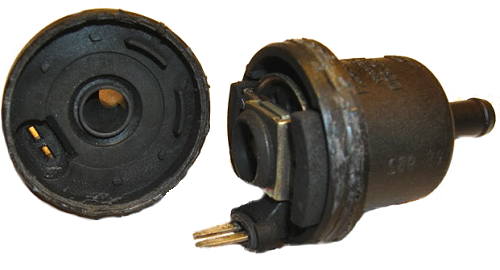
You now may remove the valve body from the case.
Step #3. Check parts and replace
Check the status of the o-rings and the rubber parts. For now, these parts are not sold separately. It would be great if they were sold as a repair kit. It isn’t much you can do about this.
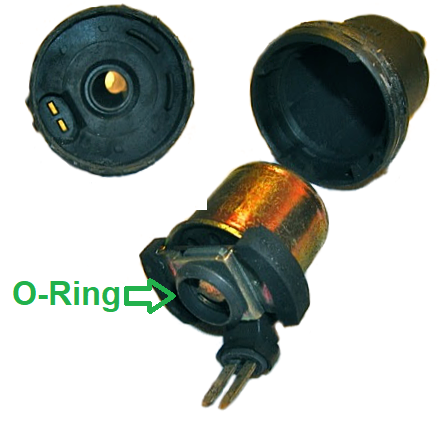
If they are in one piece, you can try to lubricate them carefully with some silicone grease. The trickiest parts are the upper rubbers and the o-ring of the top.
If you manage to get an o-ring that fits, please share it in the comments section. The lower o-ring is also important to ensure a proper seal. This one is easier to find if you consider that it needs to be replaced.

Sometimes the valve’s electrical part may be working properly, but it may be leaking because of a defective o-ring. That’s why it’s so important to seal everything back when you are reassembling the valve.
Step #4. Spray with carb or MAF cleaner
Spray the inner part of the solenoid as is shown in the picture:
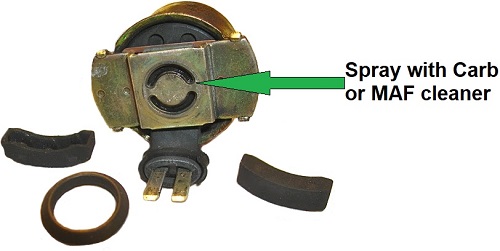
Use a good deal of Carb or MAF cleaner to do the job. For better and deep cleaning, it’s advisable to rub the orifices with a dry cloth.
Step #5. Put it back together
Once everything is cleaned and sealed, it’s time to put everything back together. Reseal the case together with Epoxy glue or RTV rubber.
Keep in mind that once you have sealed your purge solenoid valve with these products it can be very hard to open it again. Make sure that everything is well put together before you glue the two halves back.

Apply firm pressure while the glue is curing. It would be ideal to put the re-assembled valve into a vise while the glue or RTV dries.
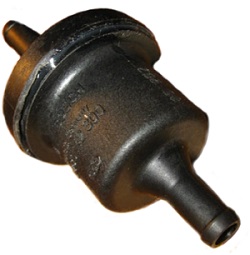
Follow your glue’s instructions to know when it’s safe to remove your fixed purge solenoid valve from the vise.
Put the purge solenoid valves back
Reinstall the valve in your car, attach the vacuum lines, and the electrical connection.
Clear the fault codes
It would be ideal to have a scanner to clear the fault codes stored in your engine’s computer and to turn off the “check engine” light from your dashboard. If you don’t have access to a scan tool don’t worry; the “check engine light” will stay on, but if the problem is fixed and it will turn off after a few driving cycles.
You should feel that your car is running better and you will hear the typical clicking of the solenoid being opened and closed while the engine is idling and warm. If your valve didn’t get fixed without opening, you may want to try the steps indicated in section “Opening and deep cleaning”.
What are the symptoms of a bad purge valve?
A bad purge solenoid valve will cause failures to the EVAP system that not only will affect the engine’s emissions output levels but could probably make the engine fail as well.
So, how do you recognize if your purge solenoid has gone bad? Here are some symptoms of a bad purge solenoid valve:
Symptom #1. Rough Idle
If the canister purge solenoid valve sticks open, it will create a vacuum leak that will make the engine run rough when idling or when the vehicle is driven at low speeds.
If the vacuum leak is too big, the engine could stall at all times, not just at low RPMs.
Symptom #2. Check engine light on the dashboard
If the ECU detects a malfunction in the EVAP system it will light up. There are several trouble codes that can turn this light ON; but there are specific codes that refer to EVAP system errors, the purge solenoid circuit, or signal.
Symptom #3. Start-up troubles
Another common symptom of a bad purge solenoid is that the engine can have start-up issues; it can be difficult to be started up. This is mostly a consequence of the vacuum leak caused by the failure of the purge solenoid.
This leak allows unmeasured air to enter the engine, which alters the air-fuel ratio required by an engine to start properly.
Symptom #4. Engine problems / Poor Engine Performance
A failing canister purge solenoid valve may cause an engine to lose power and lead to slow acceleration.
Symptom #5. Poor fuel economy
A bad canister purge solenoid valve can cause a vehicle to have poor gas mileage. This happens because the EVAP will be venting fuel vapors that were meant to be burnt by the engine.
The fuel will escape to the atmosphere instead of being used by the engine, which will cause the engine to be less fuel-efficient.
Symptom #6. Pressure build-up inside the fuel tank
When a canister purge solenoid valve is stuck closed it may cause a restriction in the fuel system that could lead to high pressure accumulating inside the fuel tank.
In conclusion…
Since the mid-1960’s many authorities from different countries have become aware of the negative impact that vehicle’s internal combustion engine emissions have on the atmosphere.
Pollution was a major concern, and by that time, there were none or poor regulations to enforce vehicle manufacturers to design more eco-friendly engines. Agencies like EPA in the USA started to take care of this matter and many devices were implemented on engines to help them reduce their emissions.
One of these devices is the “Evaporative Emission Control System”, (EVAP). The main goal of the EVAP system is to reduce the evaporative emissions of gasoline vapors caused by vehicles’ fuel systems.
Before the invention of this device, fuel systems weren’t sealed, resulting in fuel vapors venting straight into the atmosphere. EVAP system is pretty simple: the fuel vapors are conducted to a canister containing an activated carbon filter.
Once the fumes have been filtered, they go back to the engine to be burned. The purge solenoid valve (also referred to as canister purge solenoid), is one of the main components of the “Evaporative Emission Control System”, (EVAP).
This valve is controlled by the engine computer and functions as a switch, enabling or disabling the flow of the gases filtered to the engine by the canister. When the engine is OFF, this valve is closed, and when the engine is running and has reached its operational temperature, the Engine Control Unit (ECU) gradually opens the purge valve to allow the fuel vapors to flow towards the engine.

If cleaning your valve didn’t work you will have to replace it. A positive thought is that most of the time if purge solenoid valves are in good shape, a good cleaning like the one described above fixes them.
Professional services make everything easier if you don’t have time to do it…
Attention! This article is for informational purposes ONLY and is NOT a replacement for professional advice! ALWAYS consult your local specialist for an appropriate solution to your problem. All statements, prices, contact information, recommendations, and reviews contained herein came from sources that we believe to be reliable, but the accuracy or completeness thereof is not guaranteed. Please contact the service provider for complete details and updates.


